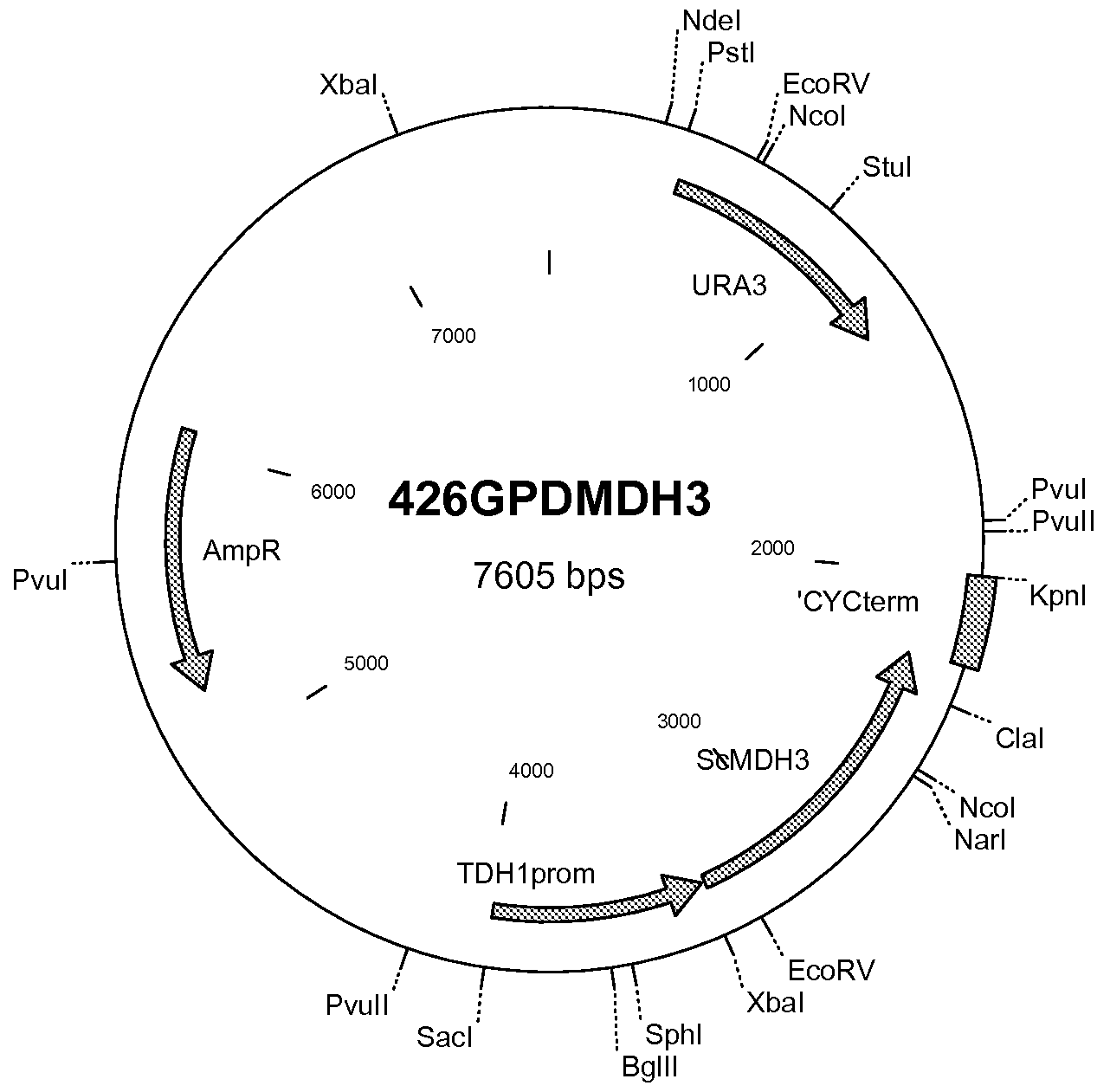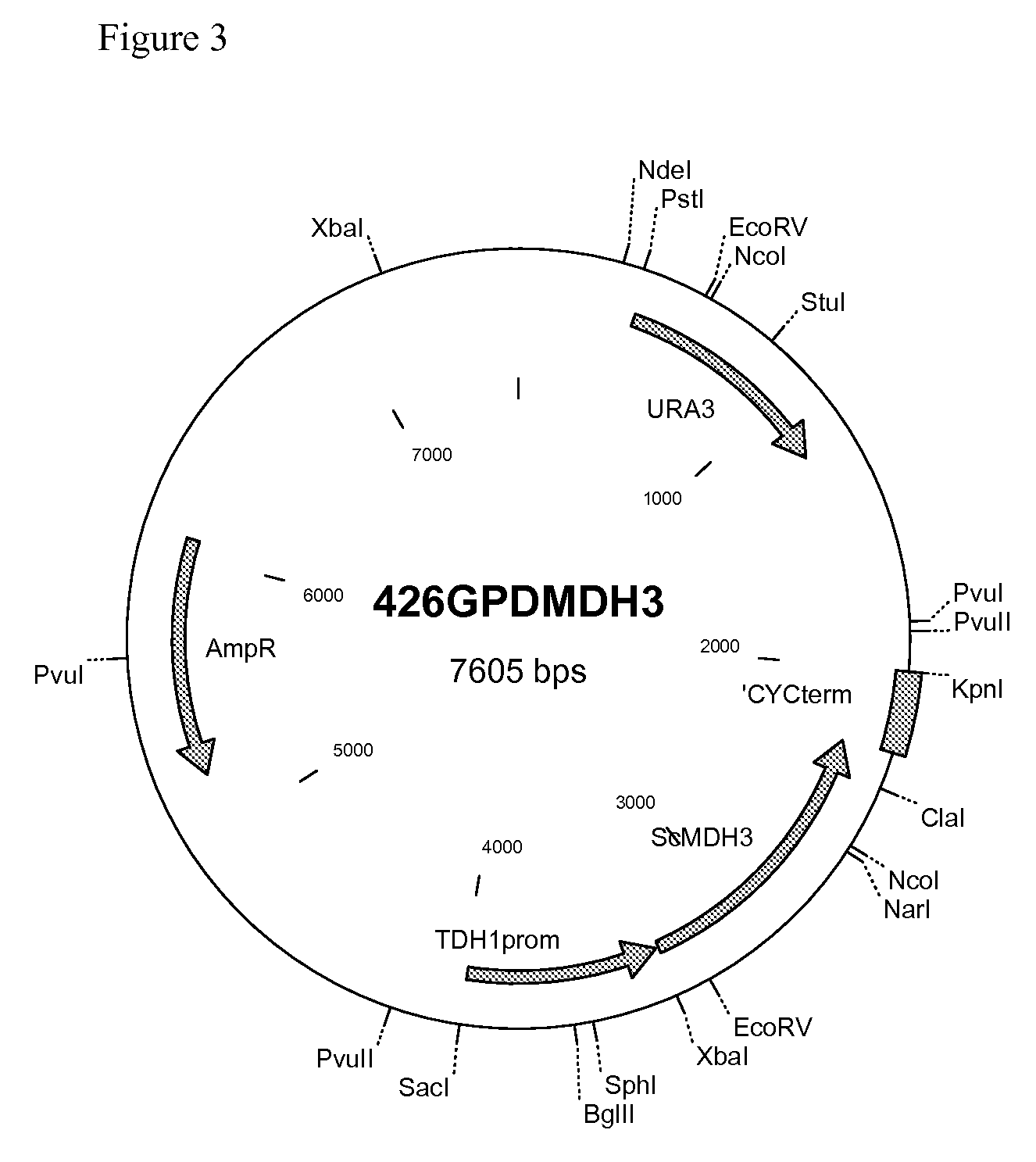Malic Acid Production in Recombinant Yeast
- Summary
- Abstract
- Description
- Claims
- Application Information
AI Technical Summary
Problems solved by technology
Method used
Image
Examples
example 1
[0086]Two yeast strains were constructed starting with S. cerevisiae strain TAM (MATa pdcl(−6,−2)::loxP pdc5(−6,−2)::loxP pdc6(−6,−2)::loxP ura3-52 (PDC-negative)), which was transformed with genes encoding a pyruvate carboxylase (PYC), a malate dehydrogenase (MDH), and a malate transporter protein (MAE).
[0087]Because the TAM strain has only one auxotrophic marker, we disrupted the TRP1 locus in order to be able to introduced more than one plasmid with an auxotrophic marker, resulting in RWB961 (MATa pdc1(−6,−2)::loxP pdc5(−6,−2)::loxP pdc6(−6,−2)::loxP mutx ura3-52 trp1::Kanlox).
[0088]The MDH and PYC genes we used had been previously cloned into plasmids p426GPDMDH3 (2μ plasmid with URA3 marker, containing the MDH3ΔSKL gene between the S. cerevisiae THD3 promoter and the S. cerevisiae CYC1 terminator, FIG. 3) and pRS2 (2μ plasmid with URA3 marker containing the S. cerevisiae PYC2 gene, FIG. 4).
[0089]A PTDII3-SpMAE1 cassette carrying the S. pombe MAE was recloned into YEplac112 (2μ,...
example 2
[0099]The effect of carbon dioxide on malate production in a fermenter system was studied using a TAM strain overexpressing PYC2, cytosolic MDH3, and a S. pombe MAE1 transporter (YEplac112SpMAE1), as described in Example 1. Three fermenter experiments were performed:
[0100]A: Batch cultivations under fully aerobic conditions.
[0101]B: Batch cultivations under fully aerobic conditions with a mixture of N2 / O2 / CO2 of 70% / 20% / 10%.
[0102]C: Batch cultivations under fully aerobic conditions with a mixture of N2 / O2 / CO2 of 65% / 20% / 15%.
[0103]Protocol
[0104]Media
[0105]The mineral medium contained 100 g glucose, 3 g KH2PO4, 0.5 g MgSO2.7H2O and 1 ml trace element solution according to Verduyn et al (Yeast 8: 501-517, 1992) per liter of demineralized water. After heat sterilization of the medium 20 min at 110° C., 1 ml filter sterilized vitamins according to Verduyn et al (Yeast 8: 501-517, 1992) and a solution containing 1 g urea were added per liter. Addition of 0.2 ml per liter antifoam (BDH) wa...
PUM
 Login to View More
Login to View More Abstract
Description
Claims
Application Information
 Login to View More
Login to View More - R&D
- Intellectual Property
- Life Sciences
- Materials
- Tech Scout
- Unparalleled Data Quality
- Higher Quality Content
- 60% Fewer Hallucinations
Browse by: Latest US Patents, China's latest patents, Technical Efficacy Thesaurus, Application Domain, Technology Topic, Popular Technical Reports.
© 2025 PatSnap. All rights reserved.Legal|Privacy policy|Modern Slavery Act Transparency Statement|Sitemap|About US| Contact US: help@patsnap.com



